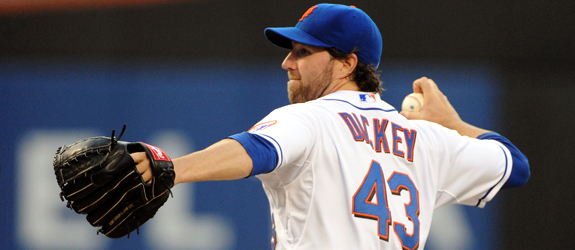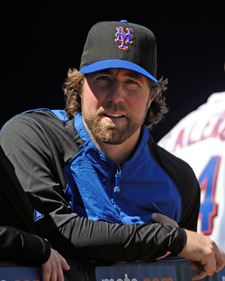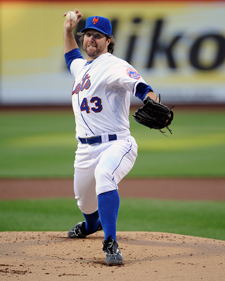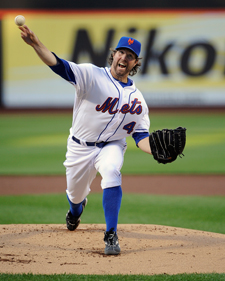
Baseball biographies come with built-in clichés about late-inning comebacks, curveballs, and Robert Redford, but the breakout success story of Mets starting pitcher Robert Alan Dickey (’97) has something most others don’t: a killer knuckleball.
However, Dickey’s knuckleball and success come only after more than a decade of hard work. Although his knuckleball has become his trademark, Dickey notes that it is only one in a long list of skills he has worked hard to cultivate in order to become a top player.
“The knuckleball is not the only reason I am pitching for the Mets,” Dickey says. “The knuckleball is only a component; it takes more than a good pitch to succeed at this level.”
As a college student at UT, Dickey was an English major, maintained a high GPA, and was an Academic All-American throughout college, thoroughly quashing the notion that athletic ability and scholastic aptitude are mutually exclusive.
 Even today, Dickey maintains several of the UT baseball program’s all-time records, and he recently became a member of the 26-man UT baseball All-Century Team. As a student, Dickey took the team to three SEC championships and to the 1995 College Baseball World Series, for the first time since 1951. Dickey was also a member of the U.S. national baseball team for the 1996 Olympic games, receiving a bronze medal.
Even today, Dickey maintains several of the UT baseball program’s all-time records, and he recently became a member of the 26-man UT baseball All-Century Team. As a student, Dickey took the team to three SEC championships and to the 1995 College Baseball World Series, for the first time since 1951. Dickey was also a member of the U.S. national baseball team for the 1996 Olympic games, receiving a bronze medal.
“For me, the most memorable thing about UT, and one that I am probably the most proud of, is the legacy that we, our team, left behind,“ he says.
To top off these feats, Dickey was drafted number one out of UT to the Texas Rangers. His future looked bright. However, his professional career hit a roadblock before it really even began.
It was something as seemingly insignificant as Dickey’s photo on the cover of a baseball magazine that sparked Texas Rangers head trainer Danny Wheat’s initial concerns regarding Dickey’s pitching arm. When Wheat saw the photo, he noticed something was out of place with Dickey’s arm, and he ordered the pitcher to undergo investigative medical testing. After it was discovered through those tests that Dickey lacked the ulnar collateral ligament in his pitching elbow—the ligament that stabilizes a pitcher’s arm while in the windup—the Rangers cut his signing bonus from $850,000 to $75,000. Dickey was born without the ligament and had never known that it was missing, even though its absence should have made everyday tasks such as turning a doorknob difficult to perform. Despite this initial setback, Dickey still managed to reach the majors.
However, at this stage Dickey met with only limited success and was not a standout among conventional pitchers. At the suggestion of Orel Hershiser, his pitching coach with the Rangers, Dickey went down to the minors mid-season in 2005 to focus and work on his pitching, specifically his knuckleball.
 The knuckleball is the most unique pitch in baseball, bar none. Its rarity largely stems from its difficulty to master, and most major league pitchers only use it occasionally, if ever. When thrown correctly, the pitch minimizes the spin of the ball in flight. The ball’s lack of axial rotation makes it subject to air currents, which account for the mercurial nature of the knuckleball. With its erratic, changeable motion, the pitch is difficult to hit, taxing to catch, and nearly impossible to predict, often even for the pitcher. Dickey is one of only two current MLB pitchers to use the knuckleball as a primary pitch.
The knuckleball is the most unique pitch in baseball, bar none. Its rarity largely stems from its difficulty to master, and most major league pitchers only use it occasionally, if ever. When thrown correctly, the pitch minimizes the spin of the ball in flight. The ball’s lack of axial rotation makes it subject to air currents, which account for the mercurial nature of the knuckleball. With its erratic, changeable motion, the pitch is difficult to hit, taxing to catch, and nearly impossible to predict, often even for the pitcher. Dickey is one of only two current MLB pitchers to use the knuckleball as a primary pitch.
Needing an edge, Dickey saw the possibility of salvation through the development of the pitch he had used before but one which he would have to truly master if he hoped to make it back into the majors. So he began cultivating his knuckleball, completely relearning how he pitched in mid-2005. Through workshops, seminars, and tireless practice, Dickey finally managed to develop his knuckleball into a reliable asset.
 “There is something to be said for really developing a skill, working hard, and living each moment well,” Dickey says. “If you can do that, at the end of the day you will be satisfied.”
“There is something to be said for really developing a skill, working hard, and living each moment well,” Dickey says. “If you can do that, at the end of the day you will be satisfied.”
All of Dickey’s work helped pave his way back to the majors, but it was by no means a straight shot. He joined several minor and major league teams between 2005 and 2009, playing for the Minnesota Twins for part of last year’s 2009 season before being taken off the roster when the team brought in player Carl Pavano. Finally, at long last, May 2010 found Dickey firmly placed back in the majors after the New York Mets purchased his contract, securing him a spot in the team’s rotation as a pitcher.
Dickey’s ability to master such a tricky pitch makes him a standout in the MLB, but he has seen enough to know that the reasons for his success are many. He credits his achievements and his ability to compete at such a high level to several important factors, some of which have nothing to do with athletics.
“Success comes from a combination of things: my life experience, career experience, the ability to take the good with the bad, having a support network of people around me, particularly my wife and family, and especially my faith, coupled with what my faith brings me, which is hope,” he says. “Hope is quintessential. My hopes have always outweighed my doubts. That is what has allowed me to succeed and what has brought me to where I am today.”
There is no question that 2010 has been a banner year professionally for Dickey, who has consistently been described by sports analysts as “dazzling” and “a bright spot” for the Mets. Of his many standout moments for the 2010 season so far, the most memorable was likely his recent performance against the Phillies, pitching an astonishing one-hit game and securing the win for the Mets. His current record distinguishes Dickey as a reliable pitcher whose knuckleball continues to grow more consistently formidable, making him a credible asset to the Mets.
It cannot have been easy, loving a game that didn’t always love him back. However, Dickey’s experience has left him surprisingly optimistic, grateful, and grounded, a welcome combination for any professional athlete.
“You have to remember to never take yourself too seriously and to realize that no one is entitled to anything except this day and these moments to live well,” he says.
—Ariel Cowen (’10)
Photo credit: Marc Levine/NY Mets

3 comments
I LOVE R.A. Dickey! I moved to NY after graduation from UT and I go to Mets games all the time. I love rooting for Dickey because he’s a fellow Tennesseean. I’m his biggest fan. Thanks for doing an article on him. LETS GO METS!
R.A. attended Montgomery Bell Academy in Nashville where, according to his plans, he hoped to become a poet. To this day he keeps fine literature at his bedside and reads with his children every night. He wanted to attend Vanderbilt, but he couldn’t get in. Vandy’s loss was UT’s gain. His is a great success story, and it couldn’t have happened to a nicer and more deserving guy.
Excellent and well-written article by Cowen on Dickey, who has endeared himself to Mets fans not only because of his unexpected success, but also for his down-to-earth personality and lack of pretentiousness and attitude as well. He’s the type of athlete you want your kids to emulate.
Comments are closed.